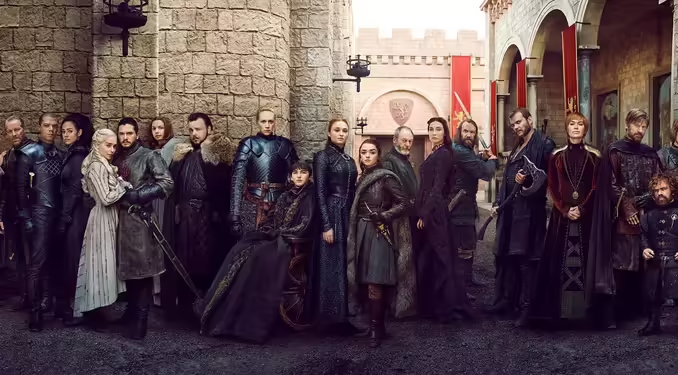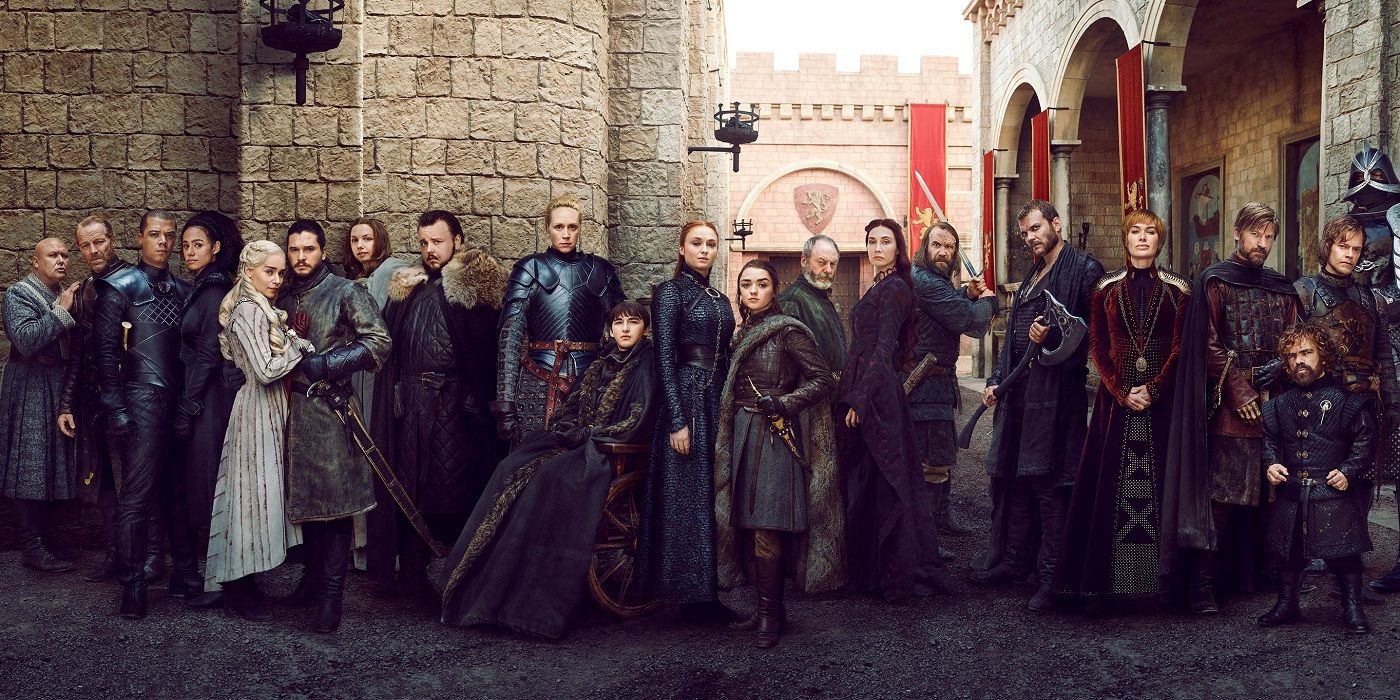
A riveting story and dynamic characters made Game of Thrones the most fascinating show during its run, even overshadowing the disappointing finale.
For its first seven seasons, Game of Thrones had a double legacy: It was simultaneously the Emmy-award winning intricate dark fantasy that encapsulated the duality of humanity, and the series with dragons, incest and nudity. Everything that made HBO the prestige network was thrown into Game of Thrones, an adaptation of George R. R. Martin’s currently ongoing and unfinished book series A Song of Ice and Fire that was developed by David Benioff and D. B. Weiss. The modern Golden Age of Television wasn’t complete without Game of Thrones’ story of whimsical politics and messianic prophecies. Then, the series finale, “The Iron Throne,” gave Game of Thrones another legacy: the series that fumbled its greatest potential.
During its eight-season run, it was hard not to hear about Game of Thrones, whether it was from friends, co-workers or the Internet. For example, Jon Snow’s (Kit Harington) death in the Season 5 finale was the talk of the town in 2015. Hodor (Kristian Nairn) holding the door was one of the most heartbreaking plot twists in television history. To top it all off, that Ed Sheeran cameo sure had people talking! Game of Thrones was glorious, blood-boiling and twisted. It was no wonder that the end of the fight for the Iron Throne and control of the Seven Kingdoms was received with a rioting backlash. But there’s a case to be made that, despite its controversial ending, Game of Thrones still deserves the television stamp of approval.
Game of Thrones Brilliantly Juggled Several Storylines Simultaneously
With Several Stories to Follow, Game of Thrones Took on Politics, Wars and Magic All at Once
The world of Game of Thrones is an incredibly busy one. It can be intimidating for first-time viewers who’ve never read Martin’s books, which are organized in massive novella-length chapters that are narrated by one major character at a time. Martin’s easily perceived structure laid the groundwork for Benioff and Weiss, who had a tremendously daring job of taking on the source material. Game of Thrones primarily follows three main plots: Jon Snow preparing for the Great War at Castle Black and North of the Wall, Daenerys Targaryen’s (Emilia Clarke) ascension to power in Essos to restore her family’s legacy as the rulers of Westeros, and the political conflicts of multiple noble families in Westeros. But even those three storylines don’t completely cover everything that goes down in Game of Thrones. Yet somehow, there’s just enough time for everyone to have their piece of the pie.
Navigating each storyline is an endless maze decorated with tenacious cobwebs. As big as it seems, the world of Game of Thrones is still a small one where everyone is connected to somebody. Characters often share namesakes as a gesture of honor, hence why some of them were blessed or cursed with recognizable nicknames based on their legacy (i.e. “Kingslayer,” “The Hound,” “Blackfish,” etc.). Over time, faces become easy to remember and crucial family secrets from before the series’ events are ingrained into viewers’ heads. The key to achieving this in a bottomless pit of lore? Don’t hold the viewer’s hand. Throw them into the pit and watch as they can climb the ladder of chaos. Game of Thrones did just that. Rarely did the show ever dump exposition in such a way that took audiences out of Westoros’ world. Lore is expertly and organically shared through natural conversations about a character’s birthright or the plagues of power.

Game of Thrones’ dialogue was a thing of beauty in its first seven seasons. Most of this is owed to Martin, who penned the most intelligent scenes in the books or even some of the best episodes, such as “Blackwater” (Season 1, Episode 9). His written conversations were so amazing and thrilling that the show practically had half of its work cut out for it. For characters who didn’t wield a sword, their words cut deeper than any blade. Tyrion Lannister (brilliantly portrayed by Peter Dinklage) admitting he’s guilty of being a dwarf was the show’s best example of a man who relied on words to fight his battles. The fruitful dialogue coupled with well-directed battle scenes made this fictional world feel lived in. Viewers might as well just throw on some armor and a blonde wig and call themselves a Westerosi lord. The escapist nature of Game of Thrones encouraged collaborative watching that fostered fulfillment.
Despite Their Fantasy Elements, Game of Thrones’ Characters Felt Real
Game of Thrones’ Characters Humanized Their Familiar Fantasy Archetypes
Now there are a lot of characters in Game of Thrones — 52 major players, to be exact. Just like its multiple storylines, that’s not counting the short-lived characters or the ones who played an integral role in events that predated the series’ present by decades or even eons. The show’s biggest characters aren’t even just the ones that stuck around for all eight seasons. They’re the ones who shaped the wars and politics that tortured Westeros or developed their own individual journey to greatness. Game of Thrones’ characters were so well-defined that they changed pop culture and how television watchers perceived anti-heroes.
Characters like Jon Snow, Daenerys Targaryen, Arya Stark (Maisie Williams), Sansa Stark (Sophie Turner) — or basically any Stark — were archetypal heroes. They were done an injustice and they embarked on journeys to fight against the traditions and laws that permitted and enabled those injustices in the first place. For this, they became the iconic faces of Game of Thrones. Then there were the inarguable villains: Joffrey Baratheon (Jack Gleeson), Ramsay Bolton (Iwan Rheon), the Night King (Vladimir Furdik and Richard Blake), and more. All these monsters were played by some of the most transformative actors to ever grace the small screen in the 2010s.
But the real heart of the morally warped and dark Game of Thrones were the anti-heroes. They’re the head-scratchers who questioned their conscience whenever they wrote off incomprehensible evil in the name of their family or some grand cause. The Lannister dynasty grew anti-heroes like poison apples on a tree. Jaime Lannister’s (Nikolaj Coster-Waldau) transformation from a corrupted knight to an honorable man is one of the best (albeit incomplete) redemption arcs in television history. Over the series’ course, Tyrion Lannister abandoned his anti-hero persona from the books, but he was still the complicated individual who fans and some characters always rooted for. Lena Headey’s portrayal as the sinister Cersei Lannister, who manipulates her various roles as queen of Westeros, doesn’t appear as a feminist triumph on the surface. The reclaiming of her agency in a patriarchal and hyper-religious society says otherwise, but she also submits to the patriarchy by destroying any woman associated with her sons to escape a prophecy. As horrendous as she is, Cersei has some are moments that make her an utterly brilliant character to watch.
Being an Adaptation Was Both a Blessing and a Curse for Game of Thrones
When Game of Thrones Ran Out of Material, It Struggled to Keep Up With Its First Few Seasons
Martin has a weird reputation. He’s one of the most gifted fantasy writers of all time, but he likes to take his sweet time with it. He cannot tweet anything without people hounding him about when the sixth novel in the series, The Winds of Winter, will finally be published. The novel’s 11-year delay labeled him as a massive procrastinator, which is unfair given the pressure that comes with perfecting an ongoing novel series as complex as Game of Thrones. But as much as people like to harp on him for the partially-written status of the book, Martin’s epic work created the most memorable moments of the HBO show. This is especially true compared to the later seasons where Benoiff and Weiss ran out of source material to adapt or follow.
Game of Thrones’ first half was a masterclass in adapting novels to the small screen. Any adaptation runs the risk of being too faithful to the books and confusing newcomers as a result, or straying too far from the material and angering longtime readers. Game of Thrones perfected the balance with a few major slugs here and there. The series succeeded at meticulously building to a momentous event, like the Red Wedding, which was already conceived by Martin. The trade-off was that the showrunners excised some storylines from the books to adjust to the television medium. This meant excluding key characters like Lady Stoneheart or the Stark children’s shared magical traits, but there’s only so much a television series can include without cluttering an already sprawling story. It also helped that, at the time, removing Game of Thrones’ more fantastical elements made the few that remained (such as dragons and the White Walkers) more impactful. It was only in hindsight when viewers realized how bad this was.
Sometimes, though, there were major errors when it came to wandering too far from the novels. Sansa Stark’s marriage to Ramsay Bolton was a grave miscalculation that left a sour taste in nearly everyone’s mouths. Whereas Sansa is still safely hiding in the Vale in the books, the series’ Sansa was sold to and raped by Ramsay as another move in Littlefinger’s (Aiden Gillen) schemes. Sansa’s violation was then written as a “necessary” point in her journey of outgrowing her childish and girlish naivety to become a cold and powerful woman. Not only was the storyline a gross endeavor of shock value, but Sansa’s transformation into an emotionless ruler — as a reaction to her trauma — destroyed any notion that a woman’s kindness can be a strength. Worse, this was one of pop culture’s most egregious examples of perpetuating the troublesome trope of how female characters can only become strong after surviving sexual violence and abandoning their female-coded “weaknesses,” like compassion.
Unfortunately, there was also a point in Game of Thrones where it was obvious that the showrunners had to start making stuff up themselves. The fifth book, A Dance With Dragons, ended with Jon Snow’s assassination and Daenerys being lost in the wild, which is precisely where Season 5 ends. From there on, the series had great some moments, such as “The Battle of the Bastards (Season 6, Episode 9)” and “The Door (Season 6, Episode 5),” but the intricate puzzle at the story’s center began to fall apart. Little details like Daenerys’ second walk-out from the flames completely contradicted the rules of the lore. Previously, Martin explained that Daenerys is not immune to fire, and that her initial survival in the pyre was a unique magical event. The storyline’s pieces and major twists were forcibly jammed into place instead of smoothly revealing themselves as they did in the first few seasons. Characters who were once renowned for their complexity lost all depth and regressed to their archetype’s flatest and most obvious readings. Arya Stark was one of this problem’s biggest offenders. In brief, she was reduced to a one-dimensional action hero by the show’s end after she spent most of the series deconstructing the sexist clichés that were inherent to male artists’ limited understandings of strong female characters. Martin’s books were an extraordinary example of what the series should’ve been. Without his input, the remaining seasons lost all nuance and wit.
